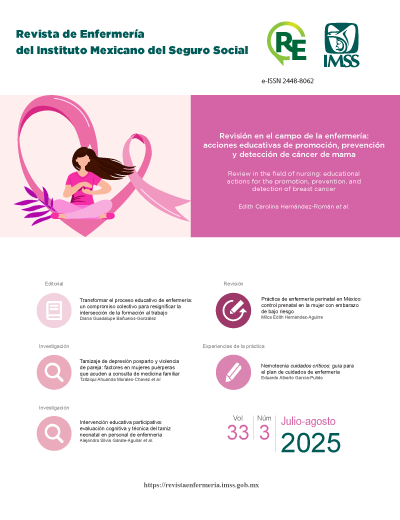Nursing interventions and expected outcomes: Burn healing process in severely burned adult patients
Main Article Content
Keywords
Burns, Nursing, Care, Treatment Outcome, Nursing Assessment
Abstract
Introduction: The care needs of adult patients with severe burns are a priority for healthcare institutions. Patient complications and staff training are essential for achieving the better outcomes.
Objective: To evaluate the burn healing process based on nursing interventions and expected outcomes for patients with severe burns.
Methodology: Descriptive cross-sectional study conducted in a sample of 24 nurses to evaluate the burn healing process. An instrument was designed and implemented based on Domain 2: Physiological Health, Class L: Tissue Integrity, and Expected Outcomes in Patients with Severe Burns, according to code 1107: Burn Recovery. The Likert scale and the indicators described were applied.
Results: Nursing staff who took part in the study obtained an overall mean score of 4 points, equivalent to Frequently demonstrated, for interventions such as documenting temperature stability, monitoring fluid status, and measuring ambulation tolerance, and Rarely demonstrated for managing psychological adaptation to changes in physical appearance.
Conclusions: Compliance with nursing interventions and expected outcomes in severely burned patients in a trauma unit was generally Sometimes demonstrated, indicating areas for improvement in interventions such as managing psychological adaptation and measuring healed body surface area.
References
Instituto Nacional de Estadística y Geografía. Nota Técnica. Estadística de defunciones registradas 2018. México: INEGI; 2018. Disponible en: https://www.inegi.org.mx/contenidos/programas/mortalidad/doc/defunciones_registradas_2018_nota_tecnica.pdf
Wilson-Carter D. Quemaduras. Manual MSD; última actualización septiembre de 2024. Disponible en: https://www.msdmanuals.com/es-mx/professional/lesiones-y-envenenamientos/quemaduras/quemaduras
Yastı AÇ, Şenel E, Saydam M, et al. Guideline and treatment algorithm for burn injuries. Ulus Travma Acil Cerrahi Derg. 2015;21(2):79-89. doi: 10.5505/tjtes.2015.88261
Rodríguez C. La Escala Lund Browder: Una Herramienta Esencial para la Evaluación de Quemaduras. CUVED; 1 de febrero de 2024. Disponible en: https://cuved.com.mx/blog/escala-lund-browder/
Lemus-Lima E, Hernández-Pérez R, Beltrán-Borao BL, et al. Efectividad del esquema de reposición hídrica de Brooke modificado para el tratamiento del paciente quemado. Revista Cubana de Enfermería. 2019;35. Disponible en: http://scielo.sld.cu/scielo.php?script=sci_arttext&pid=S0864-03192019000100006
American Burn Association. Advanced Burn Life Support Course. Chicago IL: ABLS Advisory Committee; 2018.
Mena-Tudela D, González-Chorda VM, Cervera-Gasch Á, et al. Cuidados Básicos de enfermería. España: Publicacions de la Universitat Jaume I. Servei de Comunicació i Publicacions; 2016. pp. 9-12. doi.org/10.6035/Sapientia108
Norma Oficial Mexicana 019-SSA3-2012. Para la práctica de enfermería en el sistema nacional de salud. México: Diario Oficial de la Federación; 2012. Disponible en: https://www.dof.gob.mx/nota_detalle.php?codigo=5312523&fecha=02/09/2013#gsc.tab=0
Armayor Prado M, Romero de San Pío MJ, Romero de San Pío E, et al. Sedoanalgesia en el tratamiento local hospitalario del paciente quemado. la seguridad como principio fundamental. Heridas y Cicatrización. 2021;11(3). Disponible en: https://www.heridasycicatrizacion.es/images/site/2021/SEPTIEMBRE_2021/3_Revision1_SEHER_11.3_08_10_21.pdf
Medrano-Mariscal J. Acercamiento al descriptor Enfermería Basada en la Evidencia desde una perspectiva compleja. Rev Enferm Inst Mex Seguro Soc. 2017;25(2):145-50.
Moorhead S, Swanson E, Johnson M, et al. Clasificación de resultados de enfermería. Sexta. edición. España: Elsevier; 2018.
Baillie L, Gallini A, Corser R. Psychological distress in burn patients and their care. 2014.
Norma Oficial Mexicana NOM-025-SSA2-2014, Para la atención integral a personas con enfermedades mentales. México: Diario Oficial de la Federación; 2015. Disponible en: https://www.gob.mx/salud/documentos/norma-oficial-mexicana-nom-025-ssa2-2014-secretariado-tecnico-del-consejo-nacional-de-salud-mental
Fauerbach JA, Lawrence JW, Schmidt CW Jr. Cognitive-behavioral therapy for adults with burns: an empirical review and rationale for early intervention. J Burn Care Rehabil. 2002;23.
Cagle MC, Dunn KS, Pruitt B. Cognitive-behavioral therapy for burn survivors: A systematic review. J Burn Care Res. 2019;40.
Ley General de Salud. Reglamento de la Ley General de Salud en Materia de Investigación en Salud. México; 2004.
Theron A, Bodger O, Williams D. Comparison of three techniques using the Parkland Formula to aid fluid resuscitation in adult burns. Emerg Med J. 2014;31(9):730-5. doi: 10.1136/emermed-2013-202652
Sheridan RL. Initial evaluation and management of the burn patient. MedScape; actualizado el 29 de mayo de 2024. Disponible en: http://emedicine.medscape.com/article/435402-overview#a2.
Gallach-Solano E, Pérez del Caz MD, Vivó-Benlloch C. Perfil psicológico del paciente gran quemado: prevalencia psicopatológica y variables asociadas. Cir Plást Iberolatinoam. 2015;41(4). Disponible en: https://scielo.isciii.es/scielo.php?script=sci_arttext&pid=S0376-78922015000400010


